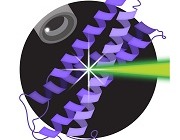Abstract:
Using spectroscopic rulers to track multiple conformations of single biomolecules and their dynamics have revolutionized the understanding of structural dynamics and its contributions to biology. While the FRET-based ruler reports on inter-dye distances in the 3-10 nm range, other spectroscopic techniques, such as protein-induced fluorescence enhancement (PIFE), report on the proximity between a dye and a protein surface in the shorter 0-3 nm range. Regardless of the method of choice, its use in measuring freely-diffusing biomolecules one at a time retrieves histograms of the experimental parameter yielding separate centrally-distributed sub-populations of biomolecules, where each sub-population represents either a single conformation that stayed unchanged within milliseconds, or multiple conformations that interconvert much faster than milliseconds, and hence an averaged-out sub-population. In single-molecule FRET, where the reported parameter in histograms is the inter-dye FRET efficiency, an intrinsically disordered protein, such as the α-Synuclein monomer in buffer, was previously reported as exhibiting a single averaged-out sub-population of multiple conformations interconverting rapidly. While these past findings depend on the 3-10 nm range of the FRET-based ruler, we sought to put this protein to the test using single-molecule PIFE, where we track the fluorescence lifetime of site-specific sCy3-labeled α-Synuclein proteins one at a time. Interestingly, using this shorter range spectroscopic proximity sensor, sCy3-labeled α-Synuclein exhibits several lifetime sub-populations with distinctly different mean lifetimes that interconvert in 10-100 ms. These results show that while α-Synuclein might be disordered globally, it nonetheless attains stable local structures. In summary, in this work we highlight the advantage of using different spectroscopic proximity sensors that track local or global structural changes one biomolecule at a time.
Publisher's Version

